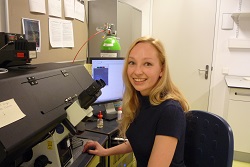Gokkende bacteriepopulaties wedden op twee paarden
Een bacteriepopulatie die achtereenvolgens op twee verschillende suikers kan groeien blijkt gokgedrag te vertonen: er wordt gewed op twee paarden. Met deze constatering ondergraven onderzoekers van de Rijksuniversiteit Groningen een ‘omschakelingstheorie’ die werd aangehangen sinds Jacques Monod deze in 1949 publiceerde. De nieuwe theorie van de Groningers is 5 mei 2014 gepubliceerd in PNAS.
Wanneer bacteriën groeien in een medium met twee verschillende suikers, nemen ze eerst de ‘lekkerste’ suiker op en – na een korte pauze –vervolgens de langzamer metaboliseerbare suiker. De pauze tussen de opeenvolgende groeifases wordt sinds een publicatie van Jacques Monod uit 1949 verklaard doordat de bacteriën hun stofwisseling moeten omschakelen. Monod is een Franse biochemicus, die in 1965 de Nobelprijs voor Geneeskunde kreeg als mede-ontdekker van onder meer het mRNA.
Leerboeken
Meer dan zeventig jaar geleden beschreef Monod het fenomeen van ‘diauxische groei’: de waarneming dat in aanwezigheid van twee verschillende suikers microbiële cellen eerst de ene suiker gebruiken en vervolgens, na een korte ‘lag-phase’, overschakelen op de andere. Tot op heden werd aangenomen dat álle cellen in een populatie betrokken waren bij de verdere groei op de tweede koolhydraat. Men dacht dat zij dit deden na een forse metabolische omschakeling waarbij, in de groeipauze, de benodigde enzymen worden aangemaakt. Wereldwijd zijn biologen opgeleid met deze verklaring in hun leerboeken.
Deelpopulatie
Onderzoekers van de afdelingen Moleculaire genetica en Theoretische biologie van de RUG hebben echter aangetoond dat niet álle cellen doorgroeien na een omschakelfase, maar dat slechts een deelpopulatie in actie komt wanneer de tweede suiker als enige koolhydraatbron is overgebleven. In een cultuur van de bacterie Lactococcus lactis bleken twee stabiele celtypes met verschillende metabolische strategieën te zijn ontstaan.
Gokgedrag
Het lijkt er daarom op dat de bacterie gokgedrag vertoont: met de productie van verschillende metabolische fenotypes wedt hij op ten minste twee paarden. De verschillende celtypes die vervolgens naast elkaar bestaan, hebben hetzelfde genotype, maar dus een ander metabolisch fenotype. Slechts één van de celtypes is in staat door te blijven groeien in de tweede fase. Evolutionair kan het gunstig zijn dat een populatie verschillende verschijningsvormen herbergt, al kost dit misschien extra energie. Bij verandering van omstandigheden kan een voorheen suboptimaal acterende deelpopulatie de situatie redden en zorgen dat de populatie doorgroeit.
‘Tweede keus’ cellobiose
Het onderzoek werd grotendeels uitgevoerd door Ana Solopova, promovenda in de Moleculaire genetica-groep van Oscar Kuipers. Zij liet L. lactis groeien op mengsels van glucose, in verschillende concentraties, en cellobiose. Steeds vond zij dat de populatie eerst exponentieel groeide op de glucose en dan na een korte pauze doorgroeide op de ‘tweede keus’ cellobiose. Daarbij viel op dat hoe meer glucose in het groeimedium zat – en dus hoe langer en beter de populatie had kunnen groeien tot deze eerste voedingsbron op was – hoe langzamer de groei op cellobiose op gang kwam.
Filmpje
Solopova wist bovendien het diauxische groeiproces met filmpjes letterlijk in beeld te brengen. Zij liet de op cellobiose groeiende cellen fluorescerend groen worden. Onder de microscoop kon zij de vermenigvuldiging van de bacteriën volgen. En zo kon zij laten zien dat na de switch naar de cellobiosebron een deel van de cellen zwart blijft. Zij delen niet meer, gaan ook niet dood, maar blijven ‘slapend’. Solopova, een van haar filmpjes tonend op haar computer: ‘You see? The black ones are a bit fluffy. But they don’t die!’

Noot voor de redactie
- Meer informatie: prof.dr. Oscar Kuipers, Moleculaire genetica, Groningen Biomolecular Sciences and Biotechnology Institute (GBB), Rijksuniversiteit Groningen.
- Op 5 mei 2014 verschenen in PNAS: Bet-hedging during bacterial diauxic shift
Ana Solopova a, Jordi van Gestel b, Franz J. Weissing b,c, Herwig Bachmann d,e, Bas Teusink d,f, Jan Kok a, e, and Oscar P. Kuipers a, e,f,1
aDepartment of Molecular Genetics, Groningen Biomolecular Sciences and Biotechnology Institute, and bTheoretical Biology Group, Centre for Ecological and Evolutionary Studies, University of Groningen, 9747 AG, Groningen, The Netherlands; cSystems Biology Centre Groningen, University of Groningen, 9713 AV, Groningen, The Netherlands; dFaculty of Earth and Life Sciences, Systems Bioinformatics, Centre for Integrative Bioinformatics Vrije Universiteit/Netherlands Institute for Systems Biology, Vrije Universiteit Amsterdam, 1081 HV, Amsterdam, The Netherlands; eTop Institute Food and Nutrition, 6700 AN, Wageningen, The Netherlands; and fKluyver Centre for Genomics of Industrial Fermentation, Groningen/Delft, The Netherlands
Meer nieuws
-
02 december 2025
Student Menna Zahran wint Unilever Research Prize
-
27 november 2025
Vliegtuigen spotten met een radiotelescoop
